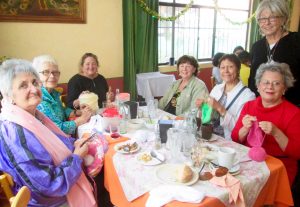One of the lasting benefits of having served as a volunteer in the United States Peace Corps, in a far-off, so-called “third world” country where tourists seldom (if ever) tread, I’ve found, is that you’re able, forever after, to feel at home just about anywhere in the world. In fact, the Peace Corps once published a collection of essays with that title: At Home in the World: The Peace Corps Story, in which one of the chapters in my Peace Corps memoir, How to Cook a Crocodile, appears.
I think it’s safe to say that the first six or so months of every Peace Corps volunteer’s two-years of service are spent doing little more than acculturating. Because the ways of life in these usually remote towns and villages in the “back of beyond” appear so different from our own, it’s a towering learning curve that can only be climbed step by step each day. Ultimately, the simple yet dazzling truth dawns: We’re not that different after all.
The townspeople and villagers Peace Corps volunteers live among have exactly the same needs and wants as we all do: nourishing food, clean water, protective clothing, safe shelter, peaceful sleep, purposeful work, human bonds, artistic expression, religious celebrations…. Once we clearly see the oneness of us all – that “they” are no different from “us” – we can’t go back to thinking otherwise. This, in my view, is the enduring takeaway of Peace Corps service.
It’s bizarre, of course, but still I’ve been harboring this fantasy lately: Someone in one of the “special forces” picks up Donald Trump and airlifts him to a remote village in Africa, let’s say, a zillion miles from Trump Tower on Fifth Avenue in New York, where he’s been living in billionaire splendor in his gilded penthouse – before he’s scheduled to move in a couple of weeks, at least part-time, into the White House in D.C.
Trump is forced to fend for himself in this African village. To survive, he must adapt: eat the local food, live alone in one of the village’s huts, learn enough of the indigenous language to get by and interact with the people. Trump is a Gemini – which is to say, a quick learner. He doesn’t need six months to acculturate.
In this, my wild and crazy fantasy, Trump returns to the U.S. a changed man. He’s lost his American rich-white-boy arrogance and his narrow, isolationist stance. He serves his Presidency with a whole new wide worldview. He’s had an epiphany. He has, to borrow an old-time-religion expression, “seen the light.”
As Mark Twain once wrote, “…nothing so liberalizes a man and expands the kindly instincts that nature put in him as travel and contact with many kinds of people.”
Well, back now to reality: The way that the unchanged billionaire businessman Donald Trump and his likeminded henchmen are likely to shape the country in the four years of Trump’s presidency may well prove to be untenable to many Americans. The country may no longer feel like “home.” My suggestion is: Don’t despair; take heart, look up and beyond, consider your options, think like an adventurous Peace Corps volunteer, and find a way to be at home somewhere else in the world. At least for the duration of Trump’s term.
I’ve already done this, and I find I’m not alone. Here in San Miguel de Allende, a beautiful old colonial city in the central mountains of Mexico, I’ve met many older American women like myself who share a strikingly similar story: We are on our own, retired after working most of our adult lives, yet unable to live in the U.S. on our meager savings and Social Security. Mexico, we’ve found to our eternal gratitude, is not only warm and beautiful, it is also affordable and embracing.
My new “soul sisters” and I, to a woman, I’ve discovered, are so thankful to be here now that we try to give back to the community in every way we can. One of my favorite ways, Hats and Scarves for Campo Kids, is a women’s group (I’ve written about before) that meets twice a week, with the mission of knitting and/or crocheting close-fitting, ear-covering hats and long, soft, warm, wrap-around scarves for children in the outlying villages who walk to school before sunup on cold mornings in the winter.
I try to attend this group – which feels to me like an old-fashioned quilting bee – every Sunday afternoon. Our numbers shrink and expand, as the Canadian “snow birds” (who are, in fact, the best knitters) and others come and go. As our hands are busy creating, we talk and laugh and share our life stories. Not surprisingly, I’ve met several former Peace Corps volunteers at the table. All indelibly at home in the world.

